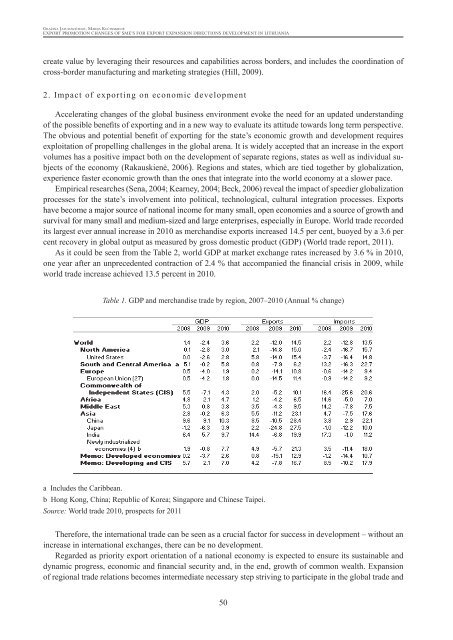Regional Formation 2012,1 - KlaipÄdos universitetas
Regional Formation 2012,1 - KlaipÄdos universitetas
Regional Formation 2012,1 - KlaipÄdos universitetas
Create successful ePaper yourself
Turn your PDF publications into a flip-book with our unique Google optimized e-Paper software.
Gražina Jatuliavičienė, Marija Kučinskienė<br />
EXPORT PROMOTION CHANGES OF SME’S FOR EXPORT EXPANSION DIRECTIONS DEVELOPMENT IN LITHUANIA<br />
create value by leveraging their resources and capabilities across borders, and includes the coordination of<br />
cross-border manufacturing and marketing strategies (Hill, 2009).<br />
2. Impact of exporting on economic development<br />
Accelerating changes of the global business environment evoke the need for an updated understanding<br />
of the possible benefits of exporting and in a new way to evaluate its attitude towards long term perspective.<br />
The obvious and potential benefit of exporting for the state’s economic growth and development requires<br />
exploitation of propelling challenges in the global arena. It is widely accepted that an increase in the export<br />
volumes has a positive impact both on the development of separate regions, states as well as individual subjects<br />
of the economy (Rakauskienė, 2006). Regions and states, which are tied together by globalization,<br />
experience faster economic growth than the ones that integrate into the world economy at a slower pace.<br />
Empirical researches (Sena, 2004; Kearney, 2004; Beck, 2006) reveal the impact of speedier globalization<br />
processes for the state’s involvement into political, technological, cultural integration processes. Exports<br />
have become a major source of national income for many small, open economies and a source of growth and<br />
survival for many small and medium-sized and large enterprises, especially in Europe. World trade recorded<br />
its largest ever annual increase in 2010 as merchandise exports increased 14.5 per cent, buoyed by a 3.6 per<br />
cent recovery in global output as measured by gross domestic product (GDP) (World trade report, 2011).<br />
As it could be seen from the Table 2, world GDP at market exchange rates increased by 3.6 % in 2010,<br />
one year after an unprecedented contraction of 2.4 % that accompanied the financial crisis in 2009, while<br />
world trade increase achieved 13.5 percent in 2010.<br />
Table 1. GDP and merchandise trade by region, 2007–2010 (Annual % change)<br />
a Includes the Caribbean.<br />
b Hong Kong, China; Republic of Korea; Singapore and Chinese Taipei.<br />
Source: World trade 2010, prospects for 2011<br />
Therefore, the international trade can be seen as a crucial factor for success in development – without an<br />
increase in international exchanges, there can be no development.<br />
Regarded as priority export orientation of a national economy is expected to ensure its sustainable and<br />
dynamic progress, economic and financial security and, in the end, growth of common wealth. Expansion<br />
of regional trade relations becomes intermediate necessary step striving to participate in the global trade and<br />
50
















